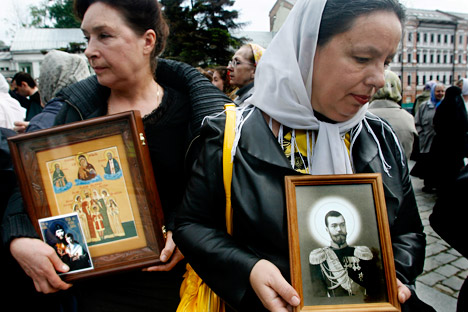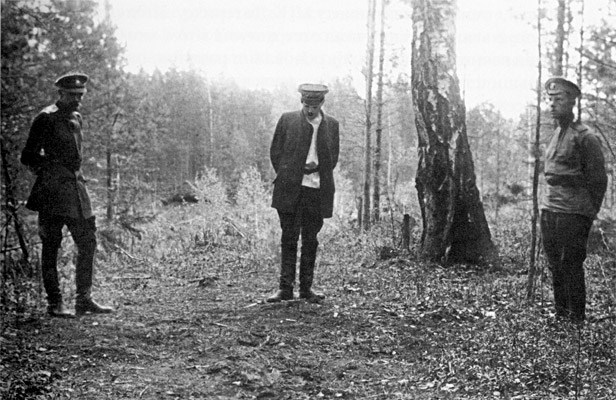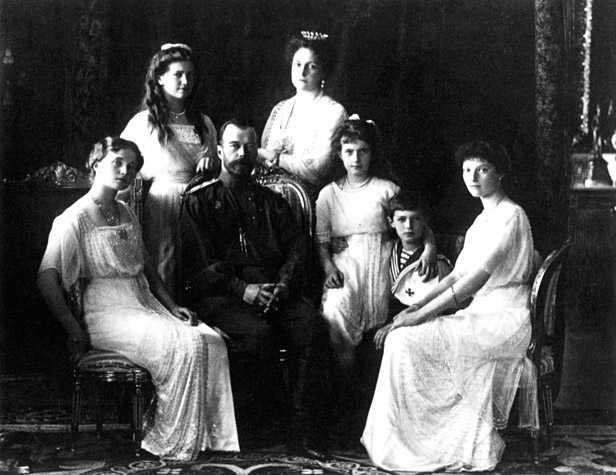
Women hold icons depicting the last Russian Czar Nicholas II.
APIn 2007 excavators found the remains of the other two family members - Alexey and Maria. Since then they have been kept in the Russian State Archive, but experts are fighting for them to be buried in the Peter and Paul Cathedral together with the royal family.
At the end of November the case was transferred to the Department of Investigation of Extremely Important Matters and the remains of Tsar Alexander III were exhumed in order to conduct further genetic analysis.
There were two investigations. The first one was carried out by White Guard (royalist) investigators Nametkin, Sergeev and Sokolov. The latter collected most of the material that played a key role in the investigation.
 Nikolai Sokolov (C). Source: Archive photo
Nikolai Sokolov (C). Source: Archive photo
The second investigation was conducted in 1993, when the Russian Prosecutor's Office launched criminal proceedings in the case.
Russian law has no statute of limitations for premeditated murders, which is why the case of the royal family was investigated.
In 2000 the Russian Orthodox Church canonized the members of the royal family, who are now venerated as "royal martyrs." That is why it is of great importance that no mistake is made in whose remains are buried in the Peter and Paul Fortress.
The church supports the position of historian and academician Benjamin Alexeev, who doubts that the "Yekaterinburg remains" belong to the royal family.
The academician cites a waitress who said she served lunch to the daughters of Nicholas II's after the official date of the murder.
Moreover, information found in an archive belonging to former investigator Sokolov points to the fact that after the Romanov's death, the Soviet government conducted talks with German diplomats on the "defense of the life of the royal family."
 Tsar Nicholas II in 1914, with his wife Alexandra and his children Olga, Tatiana, Maria, Anastasia, and Alexei. Source: Getty Images
Tsar Nicholas II in 1914, with his wife Alexandra and his children Olga, Tatiana, Maria, Anastasia, and Alexei. Source: Getty Images
Citing foreign colleagues, Alexeev also says that former German Emperor William II, being Grand Duchess Olga's godfather, provided her with a pension until 1941.
Another confusing fact is that next to the bones of the remains of Alexei and Maria the excavators found coins dating from 1930.
Many think so. For now each of his arguments has found a counter-argument: the waitress was intentionally confusing the "white investigation;" the Bolsheviks wanted to keep the murder of the royal family a secret and continued the negotiations; the 1930 coins found their way into the ground after burial.
Such a version does exist. Many believe that the burial was faked, staged by the Soviet government after the revolution, while the royal family managed to entirely or partially save themselves.
A Polish-American woman by the name of Anna Anderson used to present herself as Grand Duchess Anastasia. This was confirmed by Grand Duke Andrey, Nicholas II's cousin. However, other members of the royal house issued a Romanov Declaration in which they refused to acknowledge kinship with her.
There were at least 230 of them: 34 Anastasias, 53 Marias, 33 Tatyanas and 28 Olgas. Alexey had the most "clones" - 81. Two women even said they were the tsar's non-existent daughters: Alexandra and Irina.
It is believed that the royal family had savings in European banks. That is what the impostors ultimately sought. Anna Anderson fought the banks in court for 40 years without success.
All rights reserved by Rossiyskaya Gazeta.
Subscribe
to our newsletter!
Get the week's best stories straight to your inbox